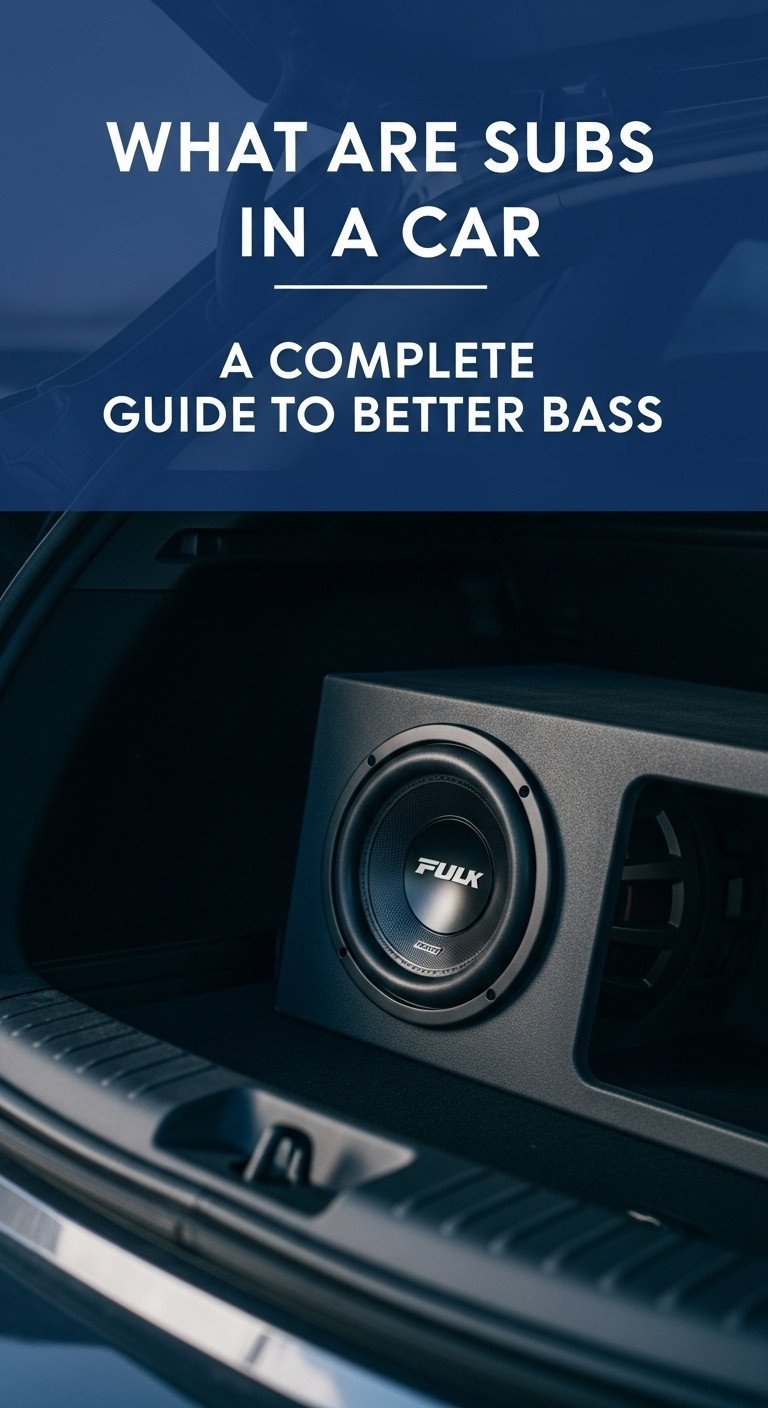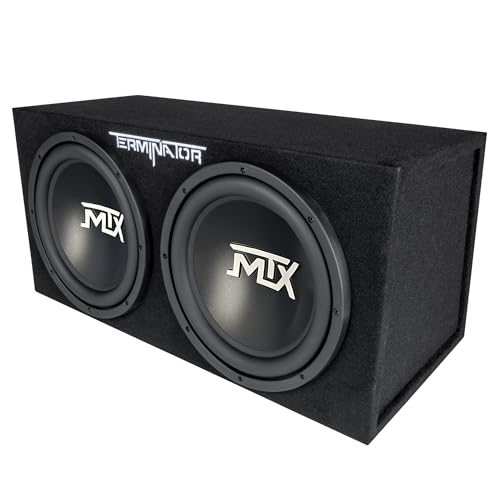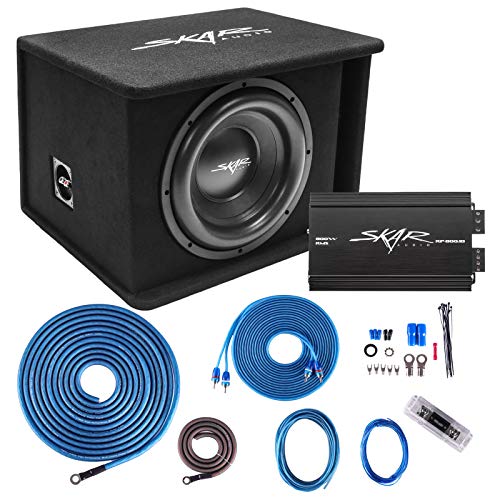Ever feel like your car stereo is missing something? You turn up the volume, but the music still sounds thin, distant, and lifeless.
A car subwoofer is the specialized loudspeaker designed to fix this exact problem. Your factory car speakers are simply too small to produce deep, low-frequency sounds. A sub’s only job is to create that missing foundation, known as bass.
A car subwoofer is a loudspeaker specifically designed to reproduce the lowest audio frequencies, known as bass, typically between 20 and 200 Hz. Adding one fills in this missing foundation, making music sound full, rich, and impactful just as the artist intended. This guide explains everything you need to know.
Key Facts
- Specialized Function: A subwoofer’s sole purpose is to reproduce deep bass frequencies (20-200 Hz), covering the lowest two octaves of human hearing which most factory car speakers cannot produce effectively.
- System Requirement: A subwoofer is not a standalone speaker; it requires an amplifier for power and an enclosure (box) to control the sound, making it a three-part system.
- Improves Overall Clarity: By handling the bass, a sub allows your other speakers to reproduce vocals and instruments with significantly less strain and distortion, as confirmed by professional installer guidelines.
- Emotional Impact: The majority of music’s emotional impact, from the kick drum to the bass guitar, resides in the frequency range only a subwoofer can accurately reproduce, according to music production studies.
- Biggest Single Upgrade: Adding a subwoofer is widely considered the single most impactful audio upgrade you can make to a standard car stereo system, offering a huge return on investment in listening enjoyment.
What Is a Car Subwoofer and How Does It Work?
A car subwoofer, or “sub,” is a specialized loudspeaker engineered exclusively to reproduce low-frequency audio sounds, known as bass and sub-bass. These are the deep, foundational notes in music, typically ranging from 20 to 200 Hertz (Hz). Standard car audio speakers are physically too small to create these deep sounds effectively, leaving a massive hole in your music. A subwoofer’s function is to fill that specific sonic gap.

Think of your car’s sound system like a band. The small speakers in your doors and dashboard are the singers and guitarists—they handle the vocals and higher-pitched instruments (mid-range and high frequencies). A subwoofer is the bass guitarist. Without it, the band sounds thin and lacks a rhythmic foundation. When you add the subwoofer, it provides the deep, resonant backbone that makes the entire band sound full, powerful, and complete. Within the context of the human hearing range (roughly 20-20,000 Hz), a car sub handles the lowest end of the spectrum that you not only hear but also feel.
Why Does Your Car Audio Need a Subwoofer?
Your factory stereo system is designed to be adequate, but it’s deliberately built without the components needed for true full-range sound. The small speakers are a compromise, forced to attempt playing all frequencies, and they fail at the lowest end. Adding a dedicated subwoofer is the solution, and its benefits go far beyond just “loud bass.”
Here’s why a car subwoofer is the most significant audio upgrade you can make:
- Adds the Missing Foundation: Music is created with bass. Without a sub, you are literally not hearing a huge part of your favorite songs. It adds the weight, warmth, and depth that makes music feel immersive.
- Improves Your Existing Speakers: This is the secret benefit most people don’t realize. When you add a sub, you can filter the deep bass away from your small speakers. Freed from the struggle of producing frequencies they weren’t designed for, they can play louder and with significantly less distortion.
- Reveals Hidden Detail: You’ll hear bass lines, kick drums, and low-end synth notes in songs you’ve listened to for years but never noticed before. It’s like seeing a movie in high-definition for the first time.
- Creates an Immersive Soundstage: Bass waves are long and non-directional, meaning they fill the cabin of your vehicle. This creates a rich, immersive listening experience that makes you feel like you’re at a live concert, not just listening to the radio.
How Does a Subwoofer Add Depth and Impact?
A subwoofer creates deep bass by using a large speaker cone to move a significant volume of air, producing long, powerful sound waves that listeners both hear and feel. Think of the difference between a small desk fan and a large industrial fan. The small fan moves a little air, but the large one creates a powerful force you can feel across the room. Similarly, a small 6-inch door speaker can’t move enough air to generate deep bass notes. A larger 10- or 12-inch subwoofer cone can push a massive volume of air, creating those low-frequency vibrations that give music its physical impact.
This effect is naturally amplified inside a car due to an acoustic principle called “cabin gain.” The small, enclosed space of a vehicle acts like a booster for low frequencies, making the bass even more powerful and efficient than it would be in a larger room.
How Does a Subwoofer Improve Overall Sound Clarity?
A subwoofer improves clarity by allowing an electronic circuit called a crossover to filter deep bass away from your smaller main speakers. A crossover acts like a traffic cop for audio frequencies. It sends the low-frequency signals (sub-bass) only to the subwoofer and its amplifier. At the same time, it blocks those same demanding frequencies from reaching your smaller door and dash speakers.
When your main speakers—like mid-range speakers responsible for vocals and guitars—are no longer straining to reproduce bass, they operate with dramatically less distortion. The result is that vocals become clearer, instruments sound more defined, and the entire system can play louder without sounding muddy or strained. This division of labor is the key to achieving clean, high-fidelity sound in your car.
What Are the Essential Parts of a Subwoofer System?
What most guides miss is a critical fact: a car subwoofer is not a single part but a system of components that must work together. Buying just the subwoofer speaker (the driver) is like buying an engine without a car. To get that better bass, you need a team of three essential items.
A complete car subwoofer system requires the subwoofer driver, an enclosure, and an amplifier. Without all three, it simply will not work. Understanding this is the most important step for any beginner to avoid wasting money on incompatible or incomplete parts.
Why Is an Amplifier (Amp) Necessary for a Subwoofer?
An amplifier is necessary because subwoofers require significantly more electrical power to move their large cones than a car stereo’s built-in amplifier can supply. An external amp provides the high-current power needed to produce deep, clean bass without distortion and to avoid damaging the stereo or the subwoofer.
Reproducing low-frequency sound is an energy-intensive job. The small, low-power amplifier built into your factory or aftermarket head unit is designed to run small speakers, not a power-hungry sub. An external amplifier takes the weak audio signal from your stereo, boosts it into a powerful signal, and sends that to the subwoofer. When matching an amp and sub, the most important specification is RMS Power, which measures the continuous, real-world power an amp can deliver and a sub can handle.
Why Does a Subwoofer Need an Enclosure (Box)?
A subwoofer driver must be mounted in a specifically designed enclosure to sound correct and prevent damage. When a subwoofer cone moves, it creates sound waves from both its front and its back. Without a box to separate them, the sound wave from the back will cancel out the sound wave from the front, resulting in almost no bass at all.
The enclosure’s job is to isolate these waves and control the cone’s movement, which is critical for shaping the final sound. The two most common types have very different characteristics:
| Feature | Sealed Enclosure | Ported (Vented) Enclosure |
|---|---|---|
| Sound Profile | Tight, accurate, musical | Loud, deep, boomy |
| Best For Music | Rock, Jazz, Classical, any genre requiring accuracy | Hip-Hop, Rap, EDM, any genre requiring high output |
| Box Size | Smaller, more compact | Larger, requires more space |
| Primary Goal | Sound Quality (SQ) | Sound Pressure Level (SPL) |
What Are the Main Types of Car Subwoofers?
Now that you understand the complete system, the next step is choosing the right type of subwoofer setup for your goals, budget, and vehicle. For beginners, the market is broken down into two main categories: component subwoofers for custom systems and powered subwoofers for simple, all-in-one solutions.
Choosing between these two paths is the first major decision you’ll make. One offers ultimate performance and flexibility, while the other offers simplicity and convenience.
What Are Component Subwoofers?
Component subwoofers are the individual building blocks of a traditional car audio bass system. When you buy a component sub, you are getting only the subwoofer driver (the speaker itself). This means you must purchase an amplifier and an enclosure separately to create a complete system.
This path is for enthusiasts who want maximum performance and the flexibility to customize their sound. You can hand-pick the perfect driver, match it with a powerful amplifier, and choose a sealed or ported enclosure that fits your exact musical tastes. While this approach offers the highest potential for sound quality and output, it is more complex and requires careful matching of all the individual parts.
What Are Powered Subwoofers?
Powered subwoofers are the convenient, all-in-one solution perfect for beginners. A powered sub combines the subwoofer driver, the amplifier, and the enclosure into a single, compact unit. The amplifier is built-in and already perfectly matched to the sub, taking all the guesswork out of the equation.
Their main advantages are simplicity and compact size. They are much easier to install and often small enough to fit under a seat or in a tight corner of your trunk, saving valuable cargo space. While they generally don’t offer the extreme output of a high-power component system, they provide a massive improvement over a factory stereo. For most people looking for their first bass upgrade, a powered subwoofer is the best and most cost-effective starting point.
FAQs About what are subs in a car
What is the difference between a woofer and a subwoofer?
A subwoofer is a specialized type of woofer. While a standard woofer in a car speaker handles a broad range of low-to-midrange frequencies, a subwoofer is engineered to focus exclusively on the very lowest frequencies (sub-bass). Think of it as the difference between a general bass instrument and a dedicated sub-bass synthesizer; the sub has a very specific and deeper job.
Are car subwoofers just for loud, obnoxious bass?
No, this is a common misconception. While subwoofers can be loud, their main purpose in a quality audio system is accuracy. A well-tuned sub adds warmth, depth, and richness to all types of music. It actually improves the clarity of vocals by relieving your smaller speakers from the strain of trying to produce bass, making the entire system sound better.
How much does a decent car subwoofer setup cost?
A quality entry-level setup typically costs between $300 and $600. This price includes the subwoofer driver, an enclosure, a suitable amplifier, and a wiring kit. All-in-one powered subwoofers, which combine these components, can sometimes be found for slightly less, while high-performance component systems can easily cost thousands of dollars.
Will a subwoofer drain my car’s battery?
When your car is running, the alternator powers the audio system, so it will not drain the battery. An audio system is just another electrical accessory. If you play a powerful system for an extended period with the engine off, it can drain the battery, similar to leaving your headlights on. For most systems under 1000 watts RMS, a standard car electrical system is sufficient.
Can a powerful subwoofer damage my car?
A subwoofer itself will not damage your car’s structure. Very powerful systems can cause vibrations and rattles in plastic interior panels or the license plate, which can be annoying but are usually fixable with sound-damping materials. The primary risk of damage to a car comes from improper electrical wiring during installation, not from the sound waves themselves.
Can I add a subwoofer to my car’s factory stereo?
Yes, you can add a subwoofer to almost any factory stereo. To do this, you will need an amplifier and a special adapter called a line output converter (LOC). The LOC is designed to tap into your factory speaker wires to create the low-level RCA signal that an aftermarket amplifier needs to power the new subwoofer.
Key Takeaways: What Are Subs in a Car?
- A Subwoofer’s Job is Specific: Its sole purpose is to reproduce deep bass frequencies (20-200 Hz) that regular car speakers can’t, providing the essential foundation for all types of music.
- A Subwoofer is a System, Not Just a Speaker: To work correctly, a subwoofer driver requires both an amplifier for power and an enclosure (box) to control the sound. You must plan and budget for all three parts.
- Benefits Go Beyond Loud Bass: A properly integrated sub makes your entire system sound better. By handling the low-end, it improves the clarity and performance of your existing speakers, allowing them to reproduce vocals and instruments more clearly.
- Powered Subs are the Easiest Starting Point: For beginners, an all-in-one powered subwoofer is the simplest, most compact, and most cost-effective way to significantly upgrade a car’s factory bass performance.
- Enclosure Type Dictates the Sound: The box your sub is in is crucial. Sealed boxes are generally smaller and provide tight, accurate bass (Sound Quality), while ported boxes are larger and deliver louder, boomy bass (High Output).
- You Can Add a Sub to Any System: Even if you want to keep your car’s basic factory stereo, components like line output converters (LOCs) make it possible to add an aftermarket amplifier and subwoofer.
Final Thoughts on Adding Subs to Your Car
Understanding what subs in a car are is the first step toward transforming your daily drive. It’s not about being the loudest car on the block; it’s about restoring the depth, impact, and emotion that is missing from nearly every factory audio system. A subwoofer is arguably the single most impactful upgrade you can make, revealing layers in your favorite music you never knew existed.
You now have the foundational knowledge to move forward. You know that a subwoofer is a specialized speaker for bass, that it requires an amplifier and an enclosure to function, and that there are simple all-in-one solutions perfect for starting out. By adding this missing piece to your car’s audio system, you’re not just adding bass—you’re adding a richer, more immersive, and far more enjoyable listening experience.
Last update on 2025-11-27 / Affiliate links / Images from Amazon Product Advertising API








